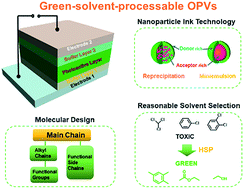Green-solvent-processable strategies for achieving large-scale manufacture of organic photovoltaics
Abstract
Organic photovoltaics (OPVs) have attracted ever-increasing attention due to the enormous potential for large-scale commercial manufacture. To date, most research studies concerning OPVs have been focused on improving the power conversion efficiencies (PCEs) and device stability. However, the state-of-the-art OPV cells especially with high PCEs are processed by highly toxic halogenated solvents. These solvents not only pollute the environment but are also harmful to human health. Moreover, the use of toxic solvents is also disadvantageous for the future large-scale commercialization of OPVs. Therefore, exploiting green-solvent-processable OPVs is urgently needed. This review emphasizes the most recent efforts in the development of green-solvent-processable OPVs, with a focus on three practicable methods including molecular design, nanoparticle ink technology and reasonable solvent selection. In this review, the requirements towards the OPVs processed by green solvents are summarized firstly. Then, the recent progress of the three strategies is described in detail. Finally, the challenges and perspectives of the three methods are also discussed. This review article is expected to inspire further interest in progressive green-solvent-processable OPVs.

- This article is part of the themed collection: Recent Review Articles


 Please wait while we load your content...
Please wait while we load your content...